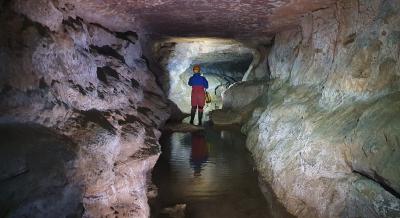Expedition Caving
What it’s all about
When you go down a cave in Britain, you can be sure that the cave has been visited by many thousands of cavers before you. The cave will almost certainly have been surveyed and you will usually be able to find a map and description in the guide book for that area. Almost the only way you are likely to find new cave is by digging choked passages (very hard work) or by diving sumps (quite dangerous).

Grotte de Douime, Dordogne. Photo © Linda Wilson
In many parts of Europe, Asia, South America and Australasia, there are vast areas of unexplored Karst containing thousands of miles of unexplored caves, caverns measureless to man and… Anyway, there are many caves left to be explored, but unlike mountains, no one knows where they are! The greatest dream of an expedition is to find a major cave that goes deep - 1000m depth is the goal that is aspired to (the depth record is at present 2223m) - or, alternatively, caves which contain large passages, chambers or river systems.
So what is expedition caving really like? Well, for a start, it is very hard work. Many months, or even years before the expedition sets out, research must be carried out into the geology of the area, permission obtained from the relevant authorities, grants applied for and sponsorship found, the list goes on. Even when you arrive at your chosen area, there may be a long walk, with heavy packs to reach the part that interests you, and then there may not be any caves. In the past, the UBSS has sent expeditions to many parts of Europe, though unfortunately, caverns measureless to man have been but few. Places that UBSS members have been include France, Slovenia, Spain, Sarawak, India, USA etc.
But don’t think that all this foreign travel is essential. Most people don’t go abroad - it’s there if you want it and can afford it (grants are available to help with the cost).
